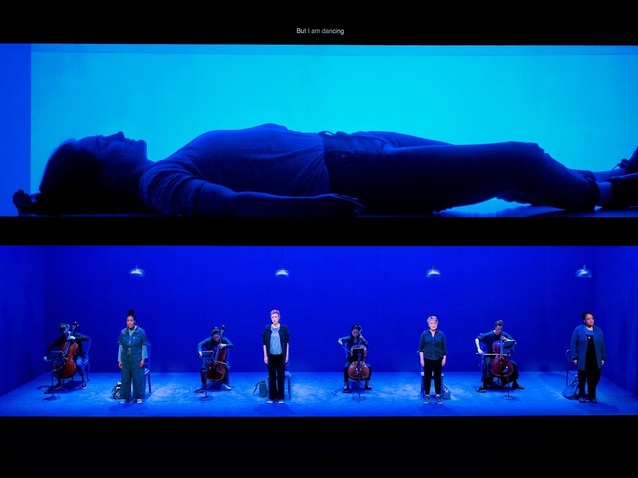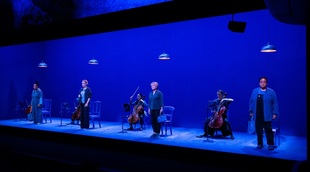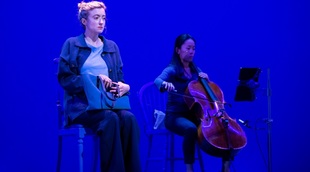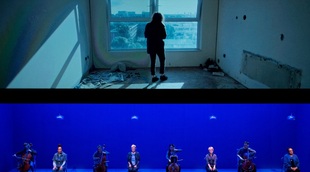 © (c) Camilla Greenwell ROH 2022
© (c) Camilla Greenwell ROH 2022
The standard operatic repertoire is full of examples of sexual and physical violence towards women. That is a fact that cannot be dismissed lightly on the grounds that most of the pieces were written a hundred or more years ago, since even today one in five women have been raped or sexually assaulted as an adult. As a result, there is still something troubling about violent acts being sensationalised and used to create moments of high drama on stage, when in reality they leave behind real life victims and long-term suffering.
To redress the balance composer Laura Bowler, librettist Laura Lomas and director Katie Mitchell have created The Blue Woman, which explores the experiences of a woman in the aftermath of a rape. As she feels she has lost a part of herself and goes on a journey to rediscover her entire person, we are invited to empathise with her by seeing everything from her perspective. The woman could stand for all women and is played here by four singers (Elaine Mitchener, Lucy Schaufer, Gweneth-Ann Rand and Rosie Middleton) who are simply entitled Woman 1 through to Woman 4. The orchestral forces are also extremely unorthodox comprising four cellos (Louise McMonagle, Su-a Lee, Tamaki Sugimoto and Clare O’Connell), a percussionist (Angela Wai-Nok Hui) and live electronics, all conducted by Jamie Man, with Jessica Cottis as the music director.
As the audience enters the Royal Opera House’s intimate Linbury Theatre, they are met by nothing more than a black front drop with a thick blue band positioned on the top half of it. This then rises to reveal, in Lizzie Clachan’s blue box-like set, the singers and cellists, with a screen now appearing where the blue band was. On this a film by Grant Gee plays out, featuring actor Eve Ponsonby, which presents the physical locations described by the woman, whether they be her own room or the streets. A ‘total work of art’ may not seem an entirely appropriate description for the piece, given that Wagner who devised it treated women in his operas in ways that this piece is fighting against, and yet it is one in the sense that singers, players, film, electronics and voice over all have equal worth as they work together to create a coherent whole. This is especially so since the direction is an integral part of the creation, with Mitchell having been involved in the development of the opera as opposed simply to directing something that had already been created.
The four singers sit slightly in front of the cellists but everyone is positioned so that we essentially see a row of eight people, with cellists and singers alternating. As a rule, the singers sit when describing how, for example, they sit in their room and stand when they venture out into the streets. The libretto is highly skilful as it features many short sentences, phrases or blocks of words whose fragmentary nature says something about the woman’s state of mind. Much of the libretto works to the principle of objective storytelling whereby the words on their own, such as ‘There’s a woman / She steps off a train / She’s in a big city, big buildings, high windows’, are fairly straight forward. However, when they are delivered within a context that enables us to bring our own personal associations and memories to mind they become highly loaded and poignant. One section is particularly powerful as Woman 4, Rosie Middleton, sometimes sings fragments of sentences, typically ‘Here where’ or simply ‘Here’, while Eleanor Henderson’s Voice Over delivers them in full.
The score includes quite a few unorthodox sounds for the cellos that capture the woman’s sense of agitation. At times they bow on the ‘wrong’ side of the bridge, play pizzicato right towards the top of the fingerboard, or stroke the strings with their bow in such a way that it elicits a sound but not actually a note. The film is also extremely effective at revealing how the memory of such a terrible incident can pervade all aspects of a person’s life. They could just be in their room when suddenly everything hits them again, inspiring all sorts of reactions. When the woman ventures outside we see her in parks, tube stations and the streets of Battersea, which are all familiar and seemingly innocuous places, and yet the filmmaking and Ponsonby’s acting create a real feeling of insecurity as if threat lies all around.
At around an hour and a quarter without pause, The Blue Woman feels quite unrelenting and that is the point. It is essentially a chamber opera and as such could not feasibly be presented on the Royal Opera House’s main stage. It was, of course, never designed to be, but it would be good if one day an opera that challenged those that sensationalise the abuse of women was written that was big enough to be presented in the same space as those that it was confronting are performed. This is because then it would truly be meeting its ‘adversaries’ on equal terms, but nevertheless The Blue Woman represents a very positive step in what is still an ongoing, and potentially long, journey.
By Sam Smith
The Blue Woman | 6 - 11 July 2022 | Linbury Theatre, Royal Opera House, Covent Garden
the 11 of July, 2022 | Print



Comments